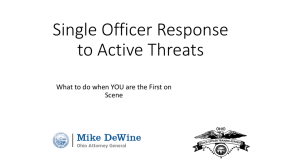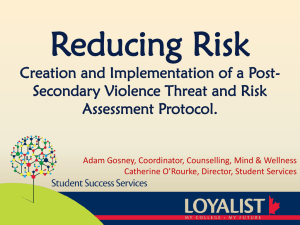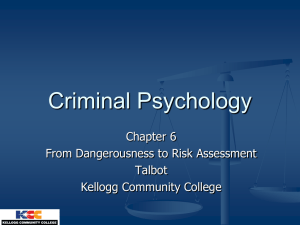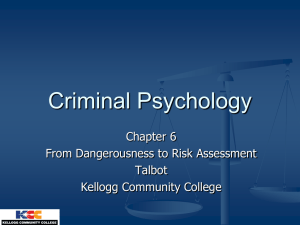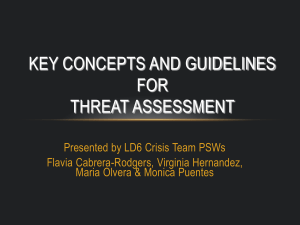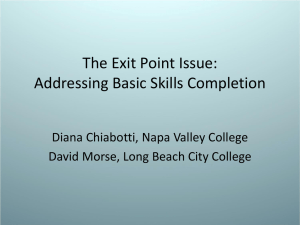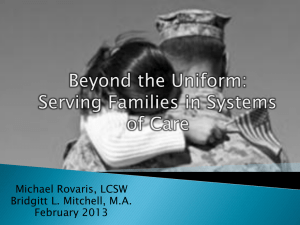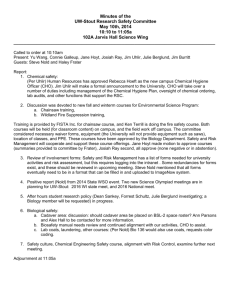targeted school violence
advertisement
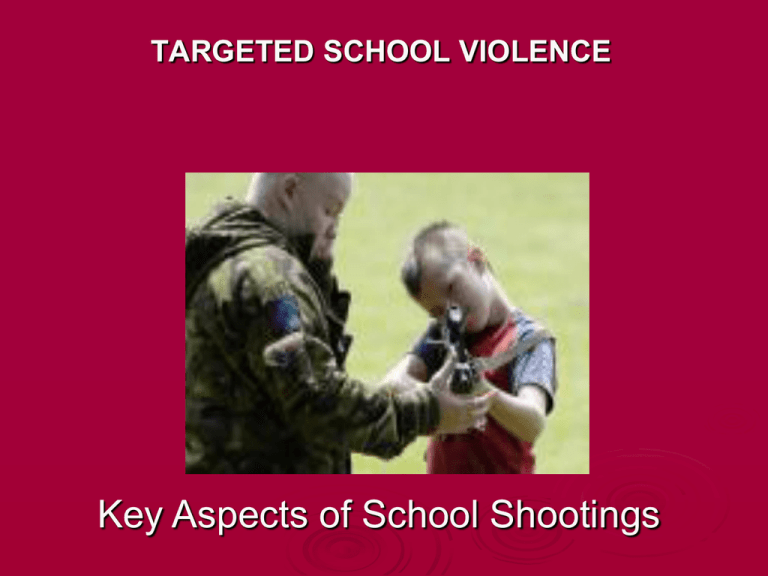
TARGETED SCHOOL VIOLENCE Key Aspects of School Shootings TARGETED SCHOOL VIOLENCE I. Overview II. Case Studies III. Best Practices TARGETED SCHOOL VIOLENCE Situational Awareness Violence/Threat/Risk Assessment Typologies (Mohandie, 2000) Type I No connection to school Type II Service recipient/customer Type III Employment-related relationship Menninger Triad (1938) Wish to die Wish to kill Wish to be killed Empty Vessel (K. Cameron 2006) Isonection (T. Beliz 2008) Panel Review Report 2007 Virginia Tech Shooting Mental health problems surfaced and managed during middle and high school. Jr. year VT clear incidents of mental instability observed by various university staff and departments. No one knew all the information and no one connected all the dots. Key Findings – Virginia Tech Office of Judicial Affairs, Cook Counseling Center, campus police, Dean of Students and others did not communicate with one another or Cho’s parents. FALSE belief that communications are prohibited by federal laws governing the privacy of health and education records. Key Findings – Virginia Tech Cook Counseling Center and university’s Care Team failed to provide needed support and services to Cho between late 2005 and early 2006. The system failed for lack of resources, incorrect interpretation of privacy laws, and passivity. Key Findings – Virginia Tech Records of Cho’s minimal treatment at VT’s Cook Counseling Center are missing. Key Findings – Virginia Tech State MH laws are flawed and services for mh users are inadequate. Limited resources (CRS, Outpt) Involuntary commitment process Barriers to open communication among key professionals Confusion about federal/state privacy laws Case Study John: 16.5 year old high school student School Admin: Received phone calls from parents of students worried about John. Parents: John telling other students he is going to bring gun to school and kill everyone in his physics and history classes. Psych: Interviews John who is quiet and verbally non-responsive. Case Study Students: Different this time around. More determined. School: Contacts local law enforcement. Law Enforcement: Dispatches patrol car. Impression: Officers: No threat. Too many “what if’s.” Student stated “I really didn’t mean it.” No criteria under Terrorist Threats for arrest. No action taken. Case Study School: VP, Psych & PO still concerned. Contacted DMH ACCESS Center PMRT: Interviewed John, VP, et al, students, and concerned parents. PMRT: Contacted and interviewed John’s legal custodian (elderly paternal aunt). Aunt: John living with her for several years. Three weeks prior observes behavioral changes. Case Study John: Writes that he worships and has seen Jesus. Believes family has been taken by the devil--to save them he must sacrifice himself or family goes to hell and burns forever. Students: John has hx of making threats. Students: 10 days before they disclose, John talks about a particular weapon, names specific students, relatives, and teachers. A neighbor’s father has the gun John references. Students: John talks about Virginia Tech shooter and expresses admiration. States he can outdo the Korean. Case Study Aunt: Disinterested/disconnected. Staring into space. Self-absorbed. Verbally aggressive, cursing, throwing objects and punching walls without provocation. Aunt: Bio father dc’ed 2 years ago, reasons unknown to relative. Biological mother allowed supervised visits only due to “past issues.” Favorite uncle died within past 7 months. Case Study Aunt: No medical/psych/substance abuse hx. No contact with juvenile justice system. PMRT: WIC 5585 as DTO. Aunt: Relieved. “He needs a lot of help. I’m worried something bad will happen.” John: Quiet. No response. Case Study Outcome: Hospitalized x 2.5 weeks. DC’ed home. Outpt plan includes medication, individual and group tx. Treatment team advised of concern. Transferred to another school with recommendations for afterschool program. Referral to Big Brother program. Dynamics Intrapersonal Low self-esteem Over-controlled hostility Self-centeredness Interpersonal Coercive-dominating behavior Submissive-passive behavior Dynamics Developmental Adolescence Young Adulthood Identity/Vocational issues Familial SES Quality of life Access to Weapons Most shooters had access to and had used weapons prior to an attack. Firearms are 18.9 times more likely to be obtained from the shooter’s home, friends or relatives (not from gangs or those with a criminal history). 69% of firearms used end in homicides, 27 % of firearms used end in suicides and 4% end in homicide/suicide. Centers for Disease Control; Morbidity, Mortality Weekly Report U.S. Dept. of Education and United States Secret Service 2002 Office of Juvenile Justice Department Threats Most threats do not lead to violence. Low risk: plan, victim and motivation are ambiguous, vague, unrealistic. Medium risk: more direct, has a possible place and time, but weapon of choice is vague. High risk: direct, specific, straightforward, plausible and explicit. National Center for the Analysis of Violent Crime: FBI Academy Notable Quotes “Something big’s going to happen.” “I am not insane. I am angry. I killed because people like me are mistreated every day. I did this to show society, push us and we will push back…” “I was angry, and I killed them because they mistreated me every day.” “I guess everyone is going to remember me now.” “I guess I’m going to be all over the news now.” Everyone that hates me, everyone that I don’t like, is going to die.” “I guess what it is about is that it is a reckoning. A settling of accounts…” Notable Quotes “My belief is that if I say something, it goes. I am the law. If you don’t like it, you die. If I don’t like you or I don’t like what you want me to do, you die…dead people can’t do many things, like argue.” “He (shooter) said on the bus that he was mad and he was going to do something stupid.” “The only thing I really learned at school was that I’m a loser…I hate people…I’m gone.” “I die like Jesus Christ, to inspire generations of the weak and defenseless people...Do you know what it feels like to be humiliated and be impaled upon a cross and left to bleed to death for your amusement?” Threat Assessment Communications Behaviors Dynamics Data Sources Backpack Dorm room/Bedroom Car/Locker Computer Threat Assessment Team approach School information Collateral interviews Parent/guardian interview Fein, Vossekuil, Pollack, Borum, Modzeleski & Reddy Threat Assessment Motives and goals Capacity to carry out attack Perception that violence is acceptable Story consistent with attacker’s actions Concern expressed by others Research or approach behaviors Fein, Vossekuil, Pollack, Borum, Modzeleski & Reddy Key Questions Motivation for behavior Communication about ideas and intent Unusual interest in targeted violence Evidence of attack related behaviors and planning Level of cognitive sophistication or organization to formulate and execute an attack plan Recent losses Consistency between communications and behaviors Concern by others about potential for harm Other factors in shooter’s life and/or environment U.S. Dept. of Education and United States Secret Service 2002 Intervention Strategies No action Monitor Arrest or detention Psychiatric hospitalization Residential program Outpatient mental health treatment Ongoing follow-up Intervention Goals Stop forward motion Surface threat and dynamics Mitigate/eliminate Establish threat comprehensive safety net Seung Hui Cho Infancy Childhood Middle (Selective Mutism) School (Suicidal/homicidal ideation + response to meds) Adolescence (IEP – counseling) Seung Hui Cho Stabs carpet with knife in presence of suitemates Poetry professor notes violence in writings Taking pix from camera held under desk Removed from class 1:1 by Dept. Chair Refuses counseling Seung Hui Cho Inappropriate internet/phone/direct contacts VTPD interviews Phone triages/no shows to Cook Couns. Ctr. IMs w strange aliases Disguised to female resident “I may as well kill myself” Seung Hui Cho VTPD transports to Psych hospital as DTO DC’ed “No threat.” Gathers no collateral info. Cook CC (x3 triaged for third time in 15 days) No appt. No follow-up. Confrontation with prof. Not reported. Seung Hui Cho Spring 2006 Writes about student who kills classmates & self Prof alerts Dean of Liberal Arts/Human Sciences No mention of VTPD or MH contacts Review Panel Recommendations Risk analysis Threat Annual Assessment Team training for students, faculty and staff on response and notification strategies Review Panel Recommendations Universities must comply with Clery Act, which requires timely public warnings of imminent danger Campus emergency communications must have multiple means of sharing information Legal Issues • • • • • • Obligation to protect the student Obligation to provide a safe school environment Right to privacy Need to inform and protect Right to education/work Exchange of Information Countywide School Threat Assessment and Response Team I. Training and Program Consultation II. Early Screening and Identification III. Assessment IV. Intervention V. Case Management & Monitoring
